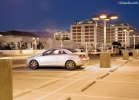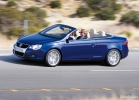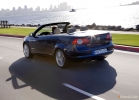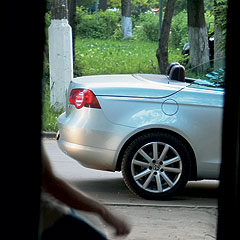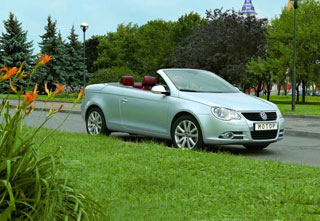Volkswagen EOS test drive since 2006 Cabriolet
Steel roof
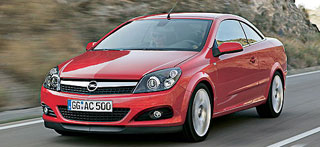 It seems that very soon the word tent will forever leave the car vocabulary. This is probably the best-a convertible with a taped top will not look like something unfinished, the vandals will be less temporary, and the buyer will be able to get two cars, paying for only one. By the current beach season, at least two more transformers appeared on the market.
It seems that very soon the word tent will forever leave the car vocabulary. This is probably the best-a convertible with a taped top will not look like something unfinished, the vandals will be less temporary, and the buyer will be able to get two cars, paying for only one. By the current beach season, at least two more transformers appeared on the market. Spartan, in principle, Opel Astra Salon in Twintop is lively with separate strokes, which is not surprising, because when
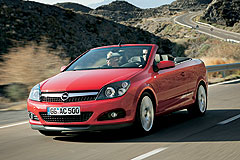 the interior laid down the ladder becomes an exterior and should not look orphans. First of all, the chrome edges of the speedometer and tachometer dials are noteworthy. For some money, a leather decoration of the salon with firmware is possible, the stitch of which, according to Opel designers, recalls the finish of riding saddles.
the interior laid down the ladder becomes an exterior and should not look orphans. First of all, the chrome edges of the speedometer and tachometer dials are noteworthy. For some money, a leather decoration of the salon with firmware is possible, the stitch of which, according to Opel designers, recalls the finish of riding saddles. Another caliber. You never noticed that the silhouettes of convertibles, when they are without a roof, are not so different from each other than when they have this roof? Now that in the hands of the designers it was not textiles taking the shape of a frame, but more susceptible to the fantasies of the artist metal, they got the opportunity to make the exterior of the car more expressive. Opel marketers draw the attention of potential buyers, which resembles Twin Top profile
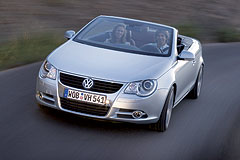 classic coupe Calibra. Relationing to the cult models of the past is a technique that a German company uses more and more often. Recall that more recently, the premiere of Opel GT took place-hello from the distant 60s.
classic coupe Calibra. Relationing to the cult models of the past is a technique that a German company uses more and more often. Recall that more recently, the premiere of Opel GT took place-hello from the distant 60s. In case of rain. One of the advantages of the Opel Cabiolet Capriolet is that not a couple of children or a dog, but four quite overall adults, if anyone is interested, can go on a journey on it. This was made possible thanks to a rather impressive wheelbase for the class, as well as due to the effective design of the hard top, consisting of three parts. They lie in the trunk exclusively compactly, leaving in it quite tolerable 205 liters. Loading and unloading are simplified thanks to the Easy Load system -
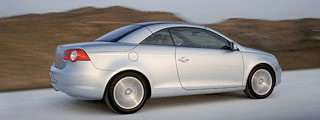 when pressing the button, the roof elements laid in the trunk lift up by 25 cm. Another convenience: the roof can be placed and put when driving at a speed of up to 30 km/h, which is convenient with suddenly starting rain or when a green traffic light found you at the time of transformation .
when pressing the button, the roof elements laid in the trunk lift up by 25 cm. Another convenience: the roof can be placed and put when driving at a speed of up to 30 km/h, which is convenient with suddenly starting rain or when a green traffic light found you at the time of transformation . Although the functional elements and controls are familiar to us by other VW models, a number of interior details of the Cabiolet compartment were re-developed. They include a driver’s place, cladding
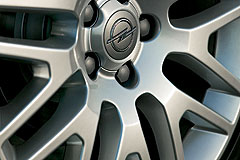 doors, rear seats, as well as a climate installation specially designed for EOS. If desired, the driver’s place and lining of the sidewalls can be performed in two colors, and in the upper part they will dominate the dark in order to minimize reflection in the glass.
doors, rear seats, as well as a climate installation specially designed for EOS. If desired, the driver’s place and lining of the sidewalls can be performed in two colors, and in the upper part they will dominate the dark in order to minimize reflection in the glass. You go quieter. The standard configuration includes air conditioning, for some reason cruise control, music, which will be useful-even at a speed of 100 km/h with a laid top in the car, you can talk without raising your voices, or listening to music without not cutting it at full power, - Seats with a memory function and heated mirrors. COSMO version - do not be surprised, there is an SUV in Vouge version - flaunts a sports wheel and a remote control system of the roof drive. The Cosmo version is default with a 200-horsepower engine.
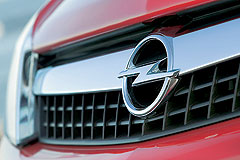 Tin button. Four gasoline engines are possible on the Astra Twin Top-1.6 l with a capacity of 105 hp, 140-horsepower 1.8 liters, as well as a two-liter pair with a turbocharger of 170 and 200 hp. Two-liter engines are equipped exclusively with 6-speed mechanics, a manual box with five steps is installed on versions of 1.6 and 1.8. In addition, the last mentioned motor can be for extra? 1360 have a 4-speed automatic transmission. Fans of diesel fans can order a 150-horsepower diesel 1.9 CDTI. The standard package of the Cabiolet compartment includes ABS and ESP, and the car can be equipped with an IDS Sportswitch function as an option, which by pressing the button on the dashboard will make the shock absorbers more rigid, enhance the rotation in the steering wheel and exacerbates the engine presses to press the gas pedal .
Tin button. Four gasoline engines are possible on the Astra Twin Top-1.6 l with a capacity of 105 hp, 140-horsepower 1.8 liters, as well as a two-liter pair with a turbocharger of 170 and 200 hp. Two-liter engines are equipped exclusively with 6-speed mechanics, a manual box with five steps is installed on versions of 1.6 and 1.8. In addition, the last mentioned motor can be for extra? 1360 have a 4-speed automatic transmission. Fans of diesel fans can order a 150-horsepower diesel 1.9 CDTI. The standard package of the Cabiolet compartment includes ABS and ESP, and the car can be equipped with an IDS Sportswitch function as an option, which by pressing the button on the dashboard will make the shock absorbers more rigid, enhance the rotation in the steering wheel and exacerbates the engine presses to press the gas pedal . 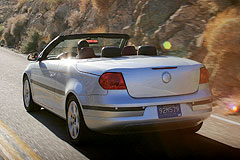 Under glass. The Cabricire-Cabiolet from Wolfsburg started on the market a little later than a similar car from Russelheim, but it would be naive to believe that engineers and designers could have time to take into account the competitors and make some adjustments-the design cycle sometimes takes several years. Nevertheless, VW EOS has a number of explicit, if not advantages, then there are definitely differences. First of all, it is a roof that is completely opening and closing in 25 seconds, which even has its own name - CSC. Its front part is made of glass and can open separately, like a sliding panoramic hatch, which is very practical and allows you to feel as if in a convertible even in the cool season. Another moment - the CSC roof made the windshield frame quite short, and therefore, above the heads of those who sit on the front seats, the sky opens significantly more. And finally, according to VW experts,
Under glass. The Cabricire-Cabiolet from Wolfsburg started on the market a little later than a similar car from Russelheim, but it would be naive to believe that engineers and designers could have time to take into account the competitors and make some adjustments-the design cycle sometimes takes several years. Nevertheless, VW EOS has a number of explicit, if not advantages, then there are definitely differences. First of all, it is a roof that is completely opening and closing in 25 seconds, which even has its own name - CSC. Its front part is made of glass and can open separately, like a sliding panoramic hatch, which is very practical and allows you to feel as if in a convertible even in the cool season. Another moment - the CSC roof made the windshield frame quite short, and therefore, above the heads of those who sit on the front seats, the sky opens significantly more. And finally, according to VW experts, 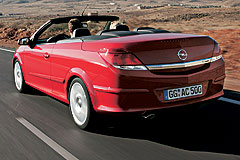 the car was originally conceived as a Cabiolet compartment, and not a convertible version of the same Jetta, for example, therefore, the roof line and visual proportions of the entire car resemble a classic convertible. They do not spoil the silhouette and antennas - they are hidden under the luggage lid. When all five parts of the roof are hidden in it, 205 liters of free space remain for baggage. The cover itself has an electric closer, which in the last millimeters pulls it to the lock.
the car was originally conceived as a Cabiolet compartment, and not a convertible version of the same Jetta, for example, therefore, the roof line and visual proportions of the entire car resemble a classic convertible. They do not spoil the silhouette and antennas - they are hidden under the luggage lid. When all five parts of the roof are hidden in it, 205 liters of free space remain for baggage. The cover itself has an electric closer, which in the last millimeters pulls it to the lock. Another moment - the CSC roof made the windshield frame quite short, and therefore, above the heads of those who sit on the front seats, the sky opens significantly more.
To Le-Man. The fact that the EOS is positioned by the manufacturer as an intermediate, supraclass car is due to the fact that the place of the once popular Golf convertible is the Beetle convertible today, so
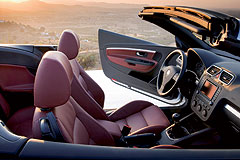 the new Cabiolet compartment should be pulled closer to Passat. This is evidenced not only by dimensions - EOS is a fairly wide car - but also the presence in the standard configuration of a semi -automatic air conditioner, fog, 16 -inch alloy discs or ESP. The list of additional options includes almost everything invented today for cars of a similar class - from seats with adjustments in 12 directions to the Le Mans package, which implies a sports running part with about 15 mm road clearance.
the new Cabiolet compartment should be pulled closer to Passat. This is evidenced not only by dimensions - EOS is a fairly wide car - but also the presence in the standard configuration of a semi -automatic air conditioner, fog, 16 -inch alloy discs or ESP. The list of additional options includes almost everything invented today for cars of a similar class - from seats with adjustments in 12 directions to the Le Mans package, which implies a sports running part with about 15 mm road clearance. 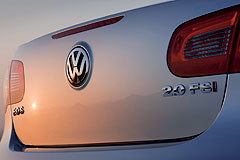 Cherries ripe. For VW EOS, the manufacturer provides a fairly wide range of engines. This is a 140-horsepower two-liter turbodiesel and four gasoline power units. Four -cylinder engines with a volume of 1.6 and 2.0 liters are able to develop 115, 150 and 200 hp. All of them are equipped exclusively by mechanical checkpoints. The robotic DSG box is possible exclusively to those who take off to the top of the EOS gamut will acquire a six-cylinder version of the Cabiolet compartment. The top model, equipped with a 250-horsepower V6, can not only accelerate to hundreds in 7.3 seconds, but will also flaunt in the database 17-inch discs, climate control, chrome ribs of the radiator lattice and cherry-colored LED rear lights.
Cherries ripe. For VW EOS, the manufacturer provides a fairly wide range of engines. This is a 140-horsepower two-liter turbodiesel and four gasoline power units. Four -cylinder engines with a volume of 1.6 and 2.0 liters are able to develop 115, 150 and 200 hp. All of them are equipped exclusively by mechanical checkpoints. The robotic DSG box is possible exclusively to those who take off to the top of the EOS gamut will acquire a six-cylinder version of the Cabiolet compartment. The top model, equipped with a 250-horsepower V6, can not only accelerate to hundreds in 7.3 seconds, but will also flaunt in the database 17-inch discs, climate control, chrome ribs of the radiator lattice and cherry-colored LED rear lights. Text Dmitry Gronsky, photo Opel and VW
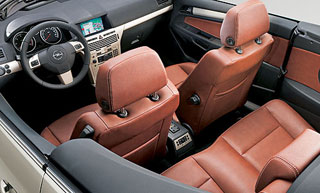 Opel Astra Twintop 2.0 Turbo
Opel Astra Twintop 2.0 Turbo Gasoline engine, with a turbocharger
Working volume (cubic meter) 1998
Power (L.S. at rpm) 200 at 5400
Moment (nm at rpm) 262 at 4200
Front drive
Gearbox 6 -t. FUR.
Length/width/height (mm) 4476/1831/1414
Equipped mass (kg) 1515
Maximum speed (km/h) 237
Acceleration to 100 km/h (c) 8.9
Fuel consumption (city/highway, l/100 km) 13.3/7.3
Price in Europe 30 295
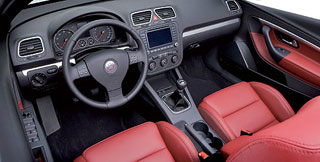 Volkswagen EOS 2.0 Turbo FSI
Volkswagen EOS 2.0 Turbo FSI Gasoline engine, with a turbocharger
Working volume (cubic meter) 1984
Power (L.S. at rpm) 200 at 5100
Moment (Nm at rpm) 280 at 1800-5000
Front drive
Gearbox 6 -t. FUR.
Length/width/height (mm) 4407/1791/1443
Equipped mass (kg) 1539
Maximum speed (km/h) 232
Acceleration to 100 km/h (c) 7.8
Fuel consumption (city/highway, l/100 km) 11.2/6.5
Price in Europe 32 350
Source: "Autopilot"
VOLKSWAGEN EOS Crash Video since 2006
Volkswagen EOS test drives since 2006
Volkswagen EOS crash test since 2006
Krassh Test: Detailed Information31%
Driver and passengers
13%
Pedestrians
40%
Children-passengers

